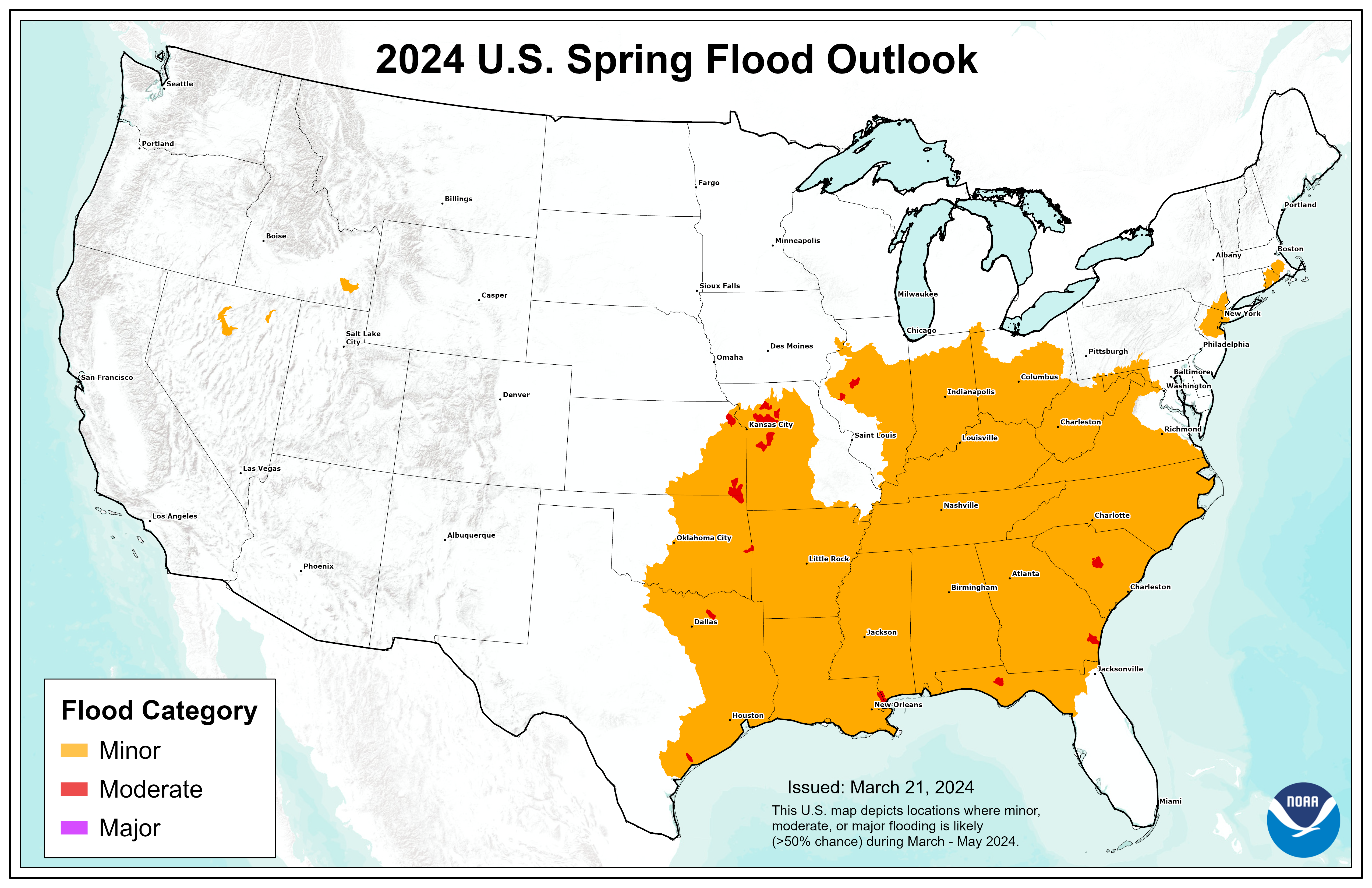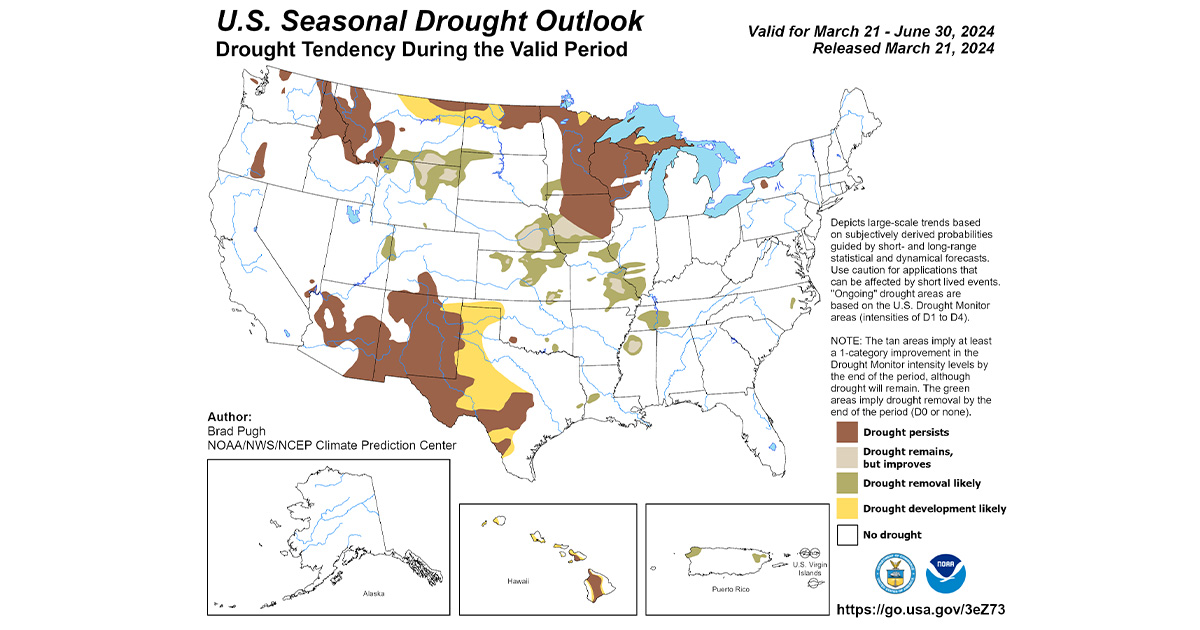Forecasters at NOAA’s Climate Prediction Center—a division of the National Weather Service—predict above-average temperatures for most of the Continental US and Alaska, as part of NOAA’s Spring Outlook released today for April through June.
Meanwhile, NOAA’s National Water Center predicts a lower-than-average flood risk across the entire country, due in part to historically low winter snow cover across the Upper Great Plains and western US
"Climate change is affecting the timing, intensity and duration of weather events in the United States,” said NOAA Administrator Rick Spinrad, Ph.D. “The Spring Outlook is one of the many tools NOAA provides to help communities prepare for what's ahead."
Spring Outlook for Drought, Temperature and Precipitation
For April through June, above-average temperatures are likely to persist across much of the US The greatest chance for above-average temperatures is in the Great Lakes region, the Pacific Northwest, and Northwest Alaska, though most of the continental US and Alaska have elevated odds of above-average temperatures.
Precipitation is slightly favored to be above average in portions of the central Plains, the southeastern US and in southern Alaska. Parts of the Pacific Northwest and Southwest, meanwhile, are most likely to see precipitation below the seasonal average.
Moderate to exceptional drought conditions currently exist across less than 20% of the US and Puerto Rico, a marked improvement from last year, as El Niño-fueled rain fell this winter across the Gulf Coast region. Drought conditions are likely to continue improving in the southeastern US; however, the drought is likely to persist or even expand through portions of the Rocky Mountains and the Great Plains.
There is an 83% probability that ENSO Neutral conditions, neither El Niño nor La Niña, will return by the April-May-June 2024 timeframe. However, El Niño is expected to continue impacting weather patterns in the US into the spring. A La Niña Watch issued by the Climate Prediction Center remains in effect—meaning La Niña conditions could return to the equatorial Pacific within six months.
“Our scientists at the Climate Prediction Center observed one of the strongest El Niño events on record during the winter of 2023–2024,” said Jon Gottschalck, Chief of the Operational Prediction Branch from NOAA’s Climate Prediction Center. “But a quick transition to La Niña—the cool phase of ENSO—is possible as early as the first part of summer.”
 This map depicts the locations where there is a greater than 50% chance of minor to major flooding during April through June 2024. (Image credit: NOAA)
This map depicts the locations where there is a greater than 50% chance of minor to major flooding during April through June 2024. (Image credit: NOAA)
Spring Flood Risk
The overall threat of significant flooding this spring is low due to above-normal temperatures and historically-low snowpack. Moderate flooding is expected in climatologically flood-prone areas of the Midwest and South. The overall lack of snowpack and significant winter precipitation, coupled with the current outlook, suggests that low flow conditions may return to main stem rivers in the Greater Mississippi River Basin later this year.
“This is the first Spring Outlook since 2021 with no population expected to be impacted by major flooding," said Ed Clark, Director, NOAA’s National Water Center. “Of growing concern will be the potentially low flows on the Mississippi River this summer into fall due to well-below snowpack and precipitation in most of the Northern Plains and Midwest. This could have potential impacts on those navigation and commercial interests that depend on water from the Mississippi River.”
Approximately 133 million people are at risk for flooding in their communities, with roughly 400,000 at risk for moderate flooding. NOAA’s National Hydrologic Assessment, issued by the National Water Center, evaluates a number of factors, including current conditions of snowpack, drought, soil saturation levels, frost depth, streamflow and precipitation.
NOAA’s Office of Water Prediction, which houses the National Water Center, has a number of exciting water initiatives on the way this year. A week from March 21, 2024, the National Water Prediction Service website is scheduled to launch, which will centralize water-related products and services by combining local and regional forecast information with new national level capabilities. The National Water Prediction Service—directed by the Flood Level Observation, Operations, and Decision Support (or FLOODS) Act of 2022—is envisioned as the gateway to all NWS water information.
Last fall, NOAA’s Office of Water Prediction unveiled its Flood Inundation Mapping services, which provide actionable information to emergency and water managers to prepare for and respond to flood impacts. It provides a real extent of flow-over areas in Geospatial Information System (GIS) format on an hourly basis, as well as a five-day flood inundation forecast. These new flood inundation mapping services—supported by the Bipartisan Infrastructure Law—initially launched in Texas and parts of the Northeast and Mid-Atlantic, are expanding to cover 30% of the US population by this fall, including much of the Ohio and Mississippi River Valleys, the Mid-Atlantic, the Pacific Northwest, Puerto Rico and the US Virgin Islands.



